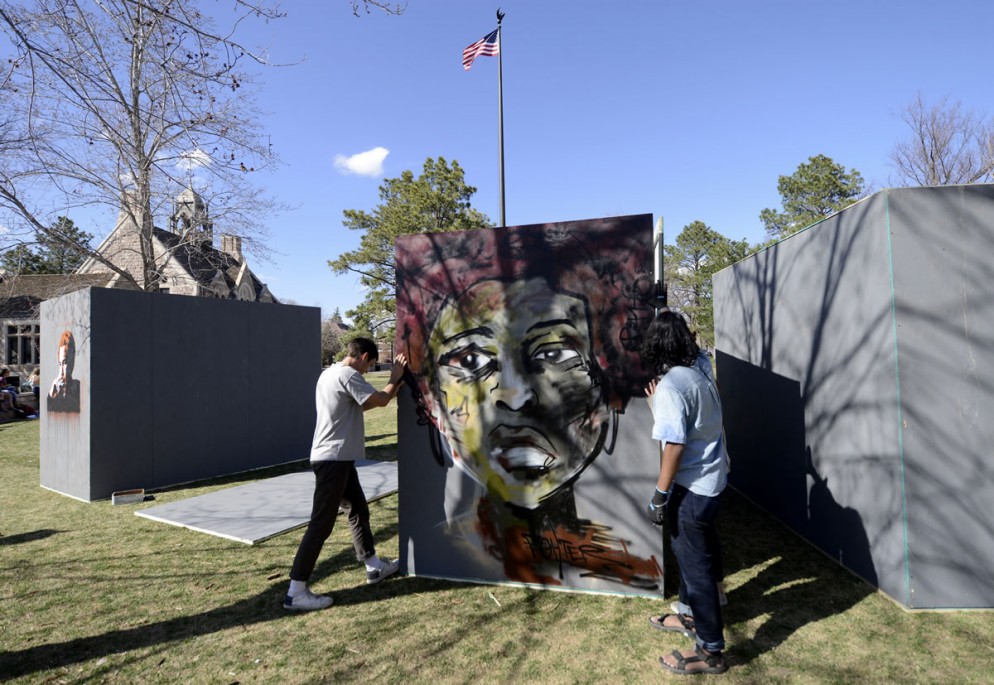By Abe Mamet ’17
In Colorado, incarcerated persons who are isolated in solitary confinement experience, on average, 23 months in a single cell with limited human contact. The Colorado College Prison Project, CC’s prison reform advocacy group, views this as a serious issue. We believe that solitary confinement is inhumane, unnecessary, and counterproductive.
To bring awareness to this practice and show solidarity with the thousands of people affected by solitary confinement in the United States, the CC Prison Project held a simulation/demonstration on Worner Quad in April. We teamed up with the Integrative Design Group, the student-run design club on campus that works to inject various modern design concepts into the CC community. Together, we designed and built five boxes the size of the average U.S. solitary cell: 6 by 10 feet and 8 feet tall. Painted a steely grey, the boxes featured murals painted by Alejandro Perez- Hobrecker ’17 and Natasha Murtha ’16, portraying three well-known people who have gone through solitary: Assata Shakur, Thomas Silverstein, and the recently released Albert Woodfox.
Two speeches were given; the first, by CC Professor of Psychology Kristi Erdal, who discussed the mental health effects of solitary confinement; the second, a riveting first-hand account from a member of the Colorado Springs community recounting his time in solitary confinement.
Then about 200 students, staff, faculty, and community members turned their attention toward the boxes. Five individuals — three students, CC Professor of History Carol Neel, and a professor from Pueblo Community College — entered them. For the next 24 hours, they stood in solidarity with individuals confined within Colorado’s “Removed from Population,” or RFP, program in which inmates are given only clothes, sheets, and three meals a day. Our participants, likewise, were allowed only a sleeping bag, small lamp, camping toilet, and three meals.
Entering the boxes, the participants were met with an oppressive loneliness. It was not necessarily quiet — there were students around, cars on Cascade Avenue, the sounds of long-boarding on Worner Quad. It was a Friday night, after all. Yet the newly confined couldn’t experience any of it, they couldn’t see it, they couldn’t interact with it. They found different methods of comfort: Some sat cross-legged and meditated, some scratched words and consoling phrases on the walls. After 24 hours, a crowd gathered on the quad. The previously confined exited the boxes, which were left on Worner Quad for students to enter and experience in their own way. The murals were kept, the wood was donated, and the boxes were eventually removed. What remained were eerie dead spots in the grass, a reminder that the effects of solitary last far longer than a constructed cell.
By Rebekah Adair ’16
While planning the “Inside the Box” event, we wanted to be careful to keep the attention away from the identities of the people in the box. The point was to focus on the concept that there are actual humans who are forced to live inside 6 by 10-foot cells for months and years at a time. Our simulation attempted to capture the experience, but it was nothing like what someone in solitary confinement faces. I knew that in 24 hours I would be back in the world with my friends and classmates. That knowledge carried me through the time I spent alone.
I consider myself a relatively emotionally and mentally stable character, but in those 24 hours my mind started to drift toward dark places. It was a constant struggle to stay positive; my mind naturally wanted to escape to darkness the minute I stopped paying attention. I have had incredible advantages in my life compared to most people in prison. There can really be no comparison to my experience alone in a box and the fight that those in solitary fight every second of every day. If my mind can so naturally steer itself to darkness when experiencing solitude for a very short period of time, I cannot fathom how we as a culture can put men and women who have gone through hell in their lives in a cement cell.
Any trauma that someone has experienced in his or her life is magnified by solitude. If you’ve never learned how to deal with terrible pain, it will consume you the minute there is no longer anything to distract your mind. That is what we are doing to people in solitary confinement.
